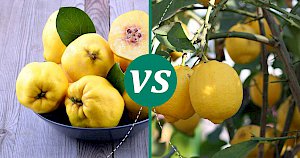Lemon vs Quince Fruit: Nutrition & Calories Compare


Lemon vs Quince fruit
Nutrition Facts
Serving size:
change
5g10g15g20g30g40g50g60g80g100g120g140g160g180g200g220g250g300g350g400g450g500g600g700g800g900g1000g
1oz2oz3oz4oz5oz6oz7oz8oz10oz12oz15oz20oz25oz30oz35oz40oz50oz
Amount Per Serving:
Serving size:
change
5g10g15g20g30g40g50g60g80g100g120g140g160g180g200g220g250g300g350g400g450g500g600g700g800g900g1000g
1oz2oz3oz4oz5oz6oz7oz8oz10oz12oz15oz20oz25oz30oz35oz40oz50oz
Amount Per Serving:
Lemon vs Quince Fruit 100g Compare
| per 100g | Lemon | Quince fruit |
|---|---|---|
| Calories | 29 | 57 |
| Carbohydrates | 9.32 g | 13.81 g |
| Fat | 0.3 g | 0.1 g |
| Dietary fiber | 2.8 g | 1.9 g |
| Protein | 1.1 g | 0.4 g |
| Calcium | 26 mg | 11 mg |
| Iron | 0.6 mg | 0.7 mg |
| Magnessium | 8 mg | 8 mg |
| Potassium | 138 mg | 119 mg |
| Sodium | 2 mg | 1 mg |
| Vitaminium A | 22 µg | 40 µg |
| Vitaminium B1 (Thiamine) | 0.04 mg | 0.02 mg |
| Vitaminium B2 (riboflavin) | 0.02 mg | 0.03 mg |
| Vitaminium B3 (Niacin) | 0.1 mg | 0.2 mg |
| Vitaminium B5 | 0.19 mg | 0.081 mg |
| Vitaminium B6 | 0.08 mg | 0.04 mg |
| Vitaminium B9 (Folic acid) | 0.011 mg | 3 mg |
| Vitaminium C | 53 mg | 15 mg |
| Vitaminium E | 0.15 mg | 0.12 mg |
Discover the Unique Qualities of Lemon and Quince Fruit
When it comes to the world of fruits, lemons and quince hold their unique spots. Lemons, with their bright yellow allure, are popular for their zesty flavor and high vitamin C content, making them a favorite in kitchens worldwide. On the other hand, the quince, with its golden-yellow hue, is cherished for its delightful fragrance and is often used in jams, jellies, and desserts. Both fruits, while different in taste and texture, offer a variety of nutritional benefits that are worth exploring.
Nutritional Insight: Lemon vs. Quince Fruit
When comparing the nutritional profiles of lemon and quince fruit, it's fascinating to see how each fruit contributes to a healthy diet. Lemons contain 29 calories per 100 grams, making them a low-calorie addition to any meal or beverage. Quince, with 57 calories per 100 grams, is slightly higher in energy but still a healthy choice. The carbohydrate content is higher in quince (13.81g) compared to lemons (9.32g), which is something to consider for those monitoring their carb intake.
Fiber is an essential part of a healthy diet, and both fruits contribute to your daily needs. Lemons provide 2.8g of fiber, while quince offers 1.9g. Although lemons lead in this category, both fruits are beneficial for digestion. When it comes to fats, both fruits are low in fat, with lemons containing 0.3g and quince only 0.1g, making them excellent choices for a low-fat diet.
Proteins are crucial for body repair and growth, and while these fruits are not high in protein, they do offer some. Lemons have 1.1g of protein, whereas quince has a modest 0.4g. Despite the lower protein content, these fruits are packed with vitamins and minerals essential for overall health.
Vitamins and Minerals: A Closer Look
Lemons are an excellent source of vitamin C, providing 53mg per 100 grams, which is essential for immune function and skin health. Quince, while lower in vitamin C (15mg), still contributes to your daily intake. Both fruits offer a range of other vitamins, such as vitamin A, which is higher in quince (40 IU vs. lemons' 22 IU), and various B vitamins, including B1, B2, B3, B5, B6, and B9, supporting energy production and cognitive function.
When it comes to minerals, both lemons and quince fruit provide magnesium, iron, and potassium, which are vital for heart health, muscle function, and more. Lemons have a slight edge in potassium (138mg vs. quince's 119mg), which is crucial for maintaining healthy blood pressure levels. Additionally, both fruits are free from cholesterol, making them heart-healthy choices.
Conclusion: Lemon vs. Quince Fruit – A Healthy Debate
While lemons and quince fruits differ in taste, texture, and nutritional profile, both offer unique health benefits that make them valuable additions to a balanced diet. Whether you're looking for a vitamin C boost from lemons or the aromatic delight of quince in your cooking, incorporating these fruits into your meals can enhance both the flavor and nutritional value of your dishes. So, the next time you're at the grocery store, consider picking up some lemons and quince to explore the delicious and healthful possibilities they offer.
Lemon 100g
29kcalCalories source
- 84% CARBS.
- 10% PROTEIN
- 6% FAT
Quince fruit 100g
57kcalCalories source
- 96% CARBS
- 3% PROTEIN
- 2% FAT
Compares of lemon
- Lemon vs Apple
- Lemon vs Apricot
- Lemon vs Avocado
- Lemon vs Banana
- Lemon vs Melon
- Lemon vs Cherries
- see all compares of lemon
Marcin Piotrowicz
calories-info.com creator
Healthy diet and healthy lifestyle promoter
Add comment